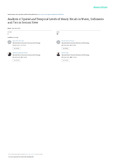| dc.contributor.author | Shieunda, Ogara Rose | |
| dc.contributor.author | Neyole, Edward | |
| dc.contributor.author | Omuterema, Stanley | |
| dc.contributor.author | Orata, Francis | |
| dc.date.accessioned | 2023-10-06T09:45:19Z | |
| dc.date.available | 2023-10-06T09:45:19Z | |
| dc.date.issued | 2019-10-09 | |
| dc.identifier.uri | https://www.researchgate.net/profile/Edward-Neyole/publication/339339920_Analysis_of_Spatial_and_Temporal_Levels_of_Heavy_Metals_in_Water_Sediments_and_Fish_in_Sosiani_River/links/5e4c4710299bf1cdb9355ce2/Analysis-of-Spatial-and-Temporal-Levels-of-Heavy-Metals-in-Water-Sediments-and-Fish-in-Sosiani-River.pdf | |
| dc.identifier.uri | http://ir-library.mmust.ac.ke:8080/xmlui/handle/123456789/2350 | |
| dc.description.abstract | The objective of the study was to examine spatial and temporal levels of heavy metals in water,
sediments and fish in Sosiani River. This study was an experimental design approach in which a scientific analysis
was done involving sample collection, preparation and laboratory work to determine Pb, Cd and Cr concentrations in
fish water and sediments. The main Sosiani river flows from the Keiyo escarpment at the far South East through
Uasin Gishu plateau to Turbo which is in the North West. The units of analysis used in the study included two
species of fish, water and sediment; whereby water and sediment were sampled from eleven sampling locations
(SR0 – SR10) and fish from ten sampling points (SR1 – SR10) along river Sosiani catchment. Sample analysis was
done using Atomic Absorption Spectrometry. Data analysis was done using the statistical program for social
sciences (SPSS) version 23. Inferential (ANOVA), regression and descriptive statistics were used to analyse data.
Spatial and temporal levels of heavy metals in water, sediments and fish were the outcomes. In the upper Sosiani,
SR3 (Chepkorio) registered the highest lead levels in the wet season of 0.127 mg/l. In both dry and wet seasons, and
in all the sites, lead values in water were above the NEMA and WHO thresholds of 0.01 mg/l. In the analysis of
cadmium concentrations, it was observed that in wet season water had all 50% of the sites above the NEMA and
WHO thresholds while all the sites were had values below the limits during the dry season. Cr in water was high for
90% of the sites. Sediment had the highest lead values of 1.744mg/l. Barbus (Barbusbarbus) fish had high lead,
cadmium and Cr values in both wet and dry seasons. In both seasons, catfish (Clariusgariapinus) had low values of
lead and cadmium below the NEMA and WHO limits for most of the sites but high levels of Chromium. Spatial and
temporal variations in heavy metal concentration were observed between the water, sediment and the two species of
fish within the catchment. This study recommended mandatory measures (enforcement) to control the increased
heavy metal concentration downstream the basin. | en_US |
| dc.language.iso | en | en_US |
| dc.publisher | International Journal of Environmental Bioremediation & Biodegradation | en_US |
| dc.subject | Analysis of Spatial and Temporal Levels of Heavy Metals in Water, Sediments and Fish in Sosiani River | en_US |
| dc.title | Analysis of Spatial and Temporal Levels of Heavy Metals in Water, Sediments and Fish in Sosiani River | en_US |
| dc.type | Article | en_US |

